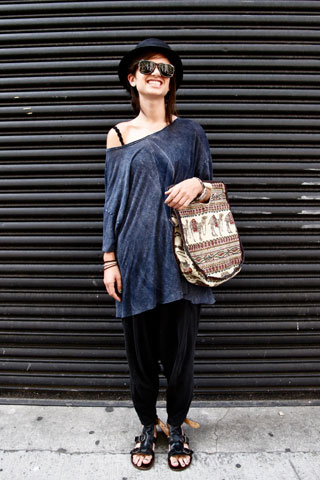Stacey Howard has made a quick rise in the world of fashion design
By Bianca Heyward
On the eighth floor of a glass building in New York City’s lower West side, Stacey Howard, 25, spends a lazy Sunday afternoon in her apartment wearing baggy black pants, and a baggy black sweater with a seemingly infinite supply of holes and rips.
She is a shoe designer who is making a name for herself in the wider world of fashion.
Her unbound creativity and resourcefulness that got her where she is now – designing shoes for the successful fashion line, Elizabeth and James, started by Mary-Kate and Ashley Olsen.
Her trajectory to success has been rapid and steep.
Howard, a Los Angeles native, attended the School of Visual Arts in New York City, where she studied graphic design. During her senior year there, she jump-started her career by catching the interest of Steve Madden, a world-renowned fashion footwear mogul, who over the past 20 years has turned his brand into a household name.
“One of my projects for school was to customize a product,” explained Howard. “So, I went down to visit my friend in Savannah. And we were going to all these military bases, like all these flea markets, and I was really into it. We found so many combat boots that they were selling in Soho for like $150. And these boots were $10. So I decided to take all the boots back to New York and buy all these clothes, and cut them up and glue them on to the boots. And so I wanted to start selling them, and someone told Steve Madden about my project, and he wanted to help.” Madden is the founder of the successful footwear company, Steve Madden Ltd.
When Howard started working with Madden, they created their own line called “Stacey and Steve”, which was sold on the Steve Madden website. It consisted of combat-style boots, which came in various colors.
While working there, Howard recalls, there was no such thing as a typical day. Exploration and creativity were not only encouraged, but, part of the job description. “At a certain point I was taking military jackets and putting fabrics on it, and he (Madden) was like ‘Alright, lets sell it in the store’”.
Her experience with Steve Madden was invaluable. Working for a large company that attracts a wide audience, the challenge, as a designer, was finding out what other people would buy.
“I’ve gone with Steve to different cities, and watched how many girls love his shoes, and how many different shoes there are. For example, the girl in Oklahoma is loving a shoe that I would never think someone would love, but it’s awesome. They’re screaming over that one shoe. So you give them a wide range [of styles], and people are happy, and he does it for a good price.”
After having spent almost two-and-a half years working with Steve Madden, Howard was ready for something different. “I didn’t even have an office,” she says laughing. “I would sit with Steve at his office. It was really cool for awhile, and then I was like alright, I’m 25 years old, I need to start actually working.”
A few months ago, Howard starting designing shoes for Elizabeth and James, which is one of Steve Maddens licenses. She works as a team alongside her co-worker, Jackson Moad. Continue reading











